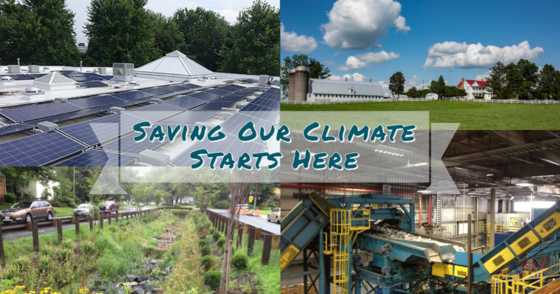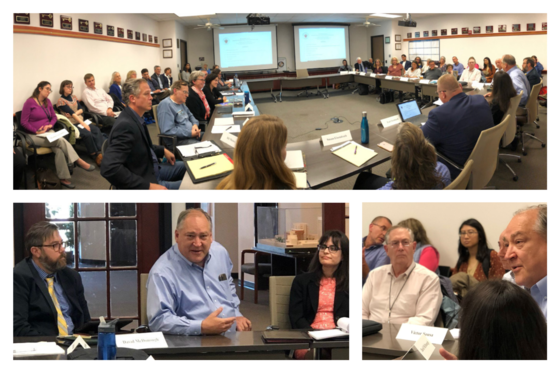|
There is nothing more global—and more local—than the dire need to reverse the climate damage that is impacting our planet and our community. Fighting climate change is one of my major priorities, and I want to share with you what my administration is doing to address the climate emergency in Montgomery County.
 County Executive
Marc Elrich

Q&A with the County Executive on the Climate Emergency
Q: What is Montgomery County doing to combat climate change?
A: We are facing a climate emergency and must take action. That is why the County has the ambitious carbon reduction goals: to achieve 80 percent reduction in greenhouse gases (GHGs) by 2027 and zero GHG emissions by 2035. Frankly this is the level of reductions we need in order to avert the most disastrous impacts of climate change. However, as we all know it will not be easy. We need to do everything we can, and we need to become a model for other jurisdictions that are trying to find a path forward.
When I became the County Executive, I appointed the county’s first climate change coordinator, Adriana Hochberg, to work directly in my office and direct the planning and implementation of climate solutions. Adriana, aka our “Climate Czarina” is charged with marshalling all our forces to address our climate emergency.
One important step has been to include as many knowledgeable and dedicated people as possible in this effort. Many Montgomery County residents have tremendous expertise on climate and energy issues. I decided to include the community and use its expertise in the County’s climate planning work, by convening five workgroups that are actively meeting now.
I am so appreciative of the approximately 150 people who are dedicating their time, energy and expertise to work on this pressing issue. Our community members understand our local context and can draw on their knowledge base to recommend solutions that will work for the County. I did not want the County to replicate climate planning studies that have been done in other places. Instead, we can learn from what others have done, and use our climate planning funds judiciously to research data and knowledge gaps, as well as to flesh out implementation steps. We can draw on the results of the recently done studies to identify ways of addressing common challenges.
The climate planning process will result in a strategic roadmap of actions to reduce GHG emissions in the County. We will also integrate climate adaptation into the plan, as we are already starting to feel the impacts of climate change here in our County, like hotter summers and more extreme storms. The recommendations in the plan will consider the impacts on the most vulnerable residents of our county and identify opportunities to enhance equity while reducing emissions.
Q: What immediate actions are you taking while the planning process is unfolding?
A: The climate planning process is not a substitute for immediate, ongoing, impactful action on climate change. While we build out the plan, we are also taking steps now on things that make sense for us to act on.
One example is a solicitation the County issued earlier this Fall for a solar energy project on the closed Oaks Landfill site. This project will generate approximately 6 megawatts of energy on a brownfields site, which will not only help to power County facilities but will also reduce the utility bills for low-and-moderate income residents who subscribe to receive the solar energy generated at this site.
The building sector makes up over 50 percent of GHG emissions generated in the County. To address building emissions, we are crafting legislation to establish energy performance standards for existing buildings. We are also working to update the green building tax incentive program to use energy efficiency as the primary factor to access tax credits. We are also working on a Zero Waste plan, which is discussed below. You can also read below how to become more informed and involved.
- Back to top

Kick-off of the Two New Climate Planning Workgroups
The County’s two newest climate planning workgroups—Community Engagement and Education and Climate Adaptation and Sequestration—convened in October for the first time. The County Executive met with members of the new workgroups and thanked them for dedicating their time and expertise in helping combat the climate emergency. The members of the new workgroups complement the work of three existing climate planning workgroups dedicated to Buildings, Clean Energy and Transportation.
More than 150 community members are participating on the five workgroups. The participants include residents with backgrounds in the public and private sectors; staff representing multiple County departments and agencies; and staff from several municipalities in the County. The workgroups are developing recommendations and prioritizing actions for the County to achieve zero greenhouse gas emissions by 2035 and adapt to an already changing climate.
“I am excited to work with other students and resources of our community to engage people and County as a whole, and spread awareness of what people can contribute,” said Abigail Kusmin, a student at Montgomery Blair High School and a member of the Community Engagement and Education workgroup. “I am also excited to see individuals across the country become interested in taking action on the climate crisis and see that it is something that we can address.”
WDMV provided coverage of the inaugural meeting of the Community Engagement and Education Workgroup:
- Back to top

Montgomery Energy Connection Launches
Department of Environmental Protection (DEP) Director Adam Ortiz, Montgomery County Public Libraries Director Anita Vassallo and Pepco Holdings, Inc. Senior Energy Efficiency Program Manager Karen Parham in October announced the launch of Montgomery Energy Connection—a new online tool that gives residents customized information to help lower their utility bills, install energy efficiency measures and consider switching to renewable energy. After the Montgomery Energy Connection launch, DEP hosted an Energy Roadshow at the Rockville Memorial Library, where residents received tips and tools from County staff to lower their energy use, make their homes more comfortable year-round, spot energy scams and switch to renewable energy.
- Back to top

The Path to Zero Waste
Montgomery County’s Department of Environmental Protection is working with the County’s Zero Waste Task Force to develop a master plan that provides a clear and realistic future vision of the County’s solid waste and recycling program and operations. The ultimate goals are to maximize waste reduction, emphasize reuse/repair, increase recycling and to establish sustainable management of materials. It will also enable the shutdown the County incinerator.
The planning effort to date has resulted in an assessment of the current facilities providing the recycling and trash disposition and a benchmarking analysis of the County’s recycling and trash operations against multiple jurisdictions in the United States. The benchmarking found that the County has a comprehensive waste management process, but in order to improve the recycling and reuse, changes may need to be made.
The next step in the process is to release an analysis of opportunities to improve recycling, reuse and sustainable management—as well as opportunities for final disposing of “What’s Left.” These opportunities include modernizing our recycling processing capacity, partnering with other jurisdictions in the region and creating programs to focus on collection of food scraps for processing.
Stay up to date on the planning process through DEP’s website at Zero Waste Planning Process.
- Back to top

Transportation Demand Management Legislation (Bill 36-18)
County Executive Marc Elrich earlier this year proposed changes to County law to expand the use of Transportation Demand Management (TDM) to more areas of the County. TDM helps employees take advantage of multi-modal transportation options to address traffic congestion and combat climate change.
TDM is implemented in five Transportation Management Districts throughout the County. These are places like Bethesda and Silver Spring, where most of the County’s higher density development has been built. Under current law, the County’s Department of Transportation offers services to employers, employees and residents in these places to reduce driving alone and promote use of public transportation, car/van pooling, telework, biking and other personal mobility choices for first-mile/last-mile connections to transit.
Under Bill 36-18, which is currently being considered by the County Council, TDM could be expanded to areas where significant commercial and multi-unit residential development is occurring, but which are outside the existing Transportation Management Districts. The bill would not apply to single-family detached or townhouse communities, nor to properties within the Agricultural Reserve. In a recent analysis of measures that local jurisdictions in the Washington region could take to reduce greenhouse gases, TDM was determined to be one of the most effective – and lowest cost – strategies available.
- Back to top
How You Can Get Involved
Residents are welcome in the climate planning workgroup meetings and can provide input during meetings. The workgroup meeting dates are posted on the County’s climate webpage at montgomerycountymd.gov/climate.
After the climate workgroups develop their recommendations in early 2020, their recommendations will be shared with the entire community and input will be invited. The public also will have an opportunity to review and comment on the draft climate action plan in Fall 2020.
|